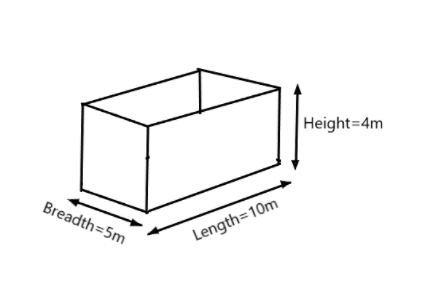
Find the total area of four walls in each rectangular room having length $ 10m $ , breadth $ 5m $ , height $ 4m $ ?
Answer
489.9k+ views
Hint: In order to find the area of four walls, first list out the things that are given, for example, length, breadth and height. Then substitute all the values in the formula to find the area of four walls: Area of four walls $ = Perimeter\left( {floor} \right) \times height $ .
Complete step-by-step answer:
We are given a rectangular room whose length is $ 10m $ , breadth is $ 5m $ and the height is $ 4m $ .
The rough diagram for the room is:

From the formula to find the Area of four walls of a rectangular room, we know that:
Area of four walls $ = Perimeter\left( {floor} \right) \times height $ .
Since, we know that Perimeter of a rectangle is $ 2\left( {length + breadth} \right) $ .
Substituting this value, the Area of four walls is expanded as:
Area of four walls $ = 2\left( {length + breadth} \right) \times height $ .
Putting the value of length, breadth and height above and we get:
$
Area = 2\left( {length + breadth} \right) \times height \\
Area = 2\left( {10 + 5} \right) \times 4 \;
$
We would be solving the formed equation further, for that initiating with solving the brackets, to get:
\[
Area = 2\left( {10 + 5} \right) \times 4 \\
Area = 2\left( {15} \right) \times 4 \\
Area = 2 \times 15 \times 4 \;
\]
Simplifying, it further we get:
$
Area = 30 \times 4 \\
Area = 120{m^2} \;
$
Therefore, the total area of four walls in each rectangular room having length $ 10m $ , breadth $ 5m $ , height $ 4m $ is $ 120\;{m^2} $ .
So, the correct answer is “ $ 120\;{m^2} $ ”.
Note: A rectangular room, is in the form of a cuboid. Area of four walls is also called the Lateral Surface area of a cuboid. Lateral Surface area is the Area of a cuboid without bases.
If we need to calculate the total surface area of the rectangular room or cuboid then just add the area of the faces of bottom or top to the lateral surface area.
Complete step-by-step answer:
We are given a rectangular room whose length is $ 10m $ , breadth is $ 5m $ and the height is $ 4m $ .
The rough diagram for the room is:

From the formula to find the Area of four walls of a rectangular room, we know that:
Area of four walls $ = Perimeter\left( {floor} \right) \times height $ .
Since, we know that Perimeter of a rectangle is $ 2\left( {length + breadth} \right) $ .
Substituting this value, the Area of four walls is expanded as:
Area of four walls $ = 2\left( {length + breadth} \right) \times height $ .
Putting the value of length, breadth and height above and we get:
$
Area = 2\left( {length + breadth} \right) \times height \\
Area = 2\left( {10 + 5} \right) \times 4 \;
$
We would be solving the formed equation further, for that initiating with solving the brackets, to get:
\[
Area = 2\left( {10 + 5} \right) \times 4 \\
Area = 2\left( {15} \right) \times 4 \\
Area = 2 \times 15 \times 4 \;
\]
Simplifying, it further we get:
$
Area = 30 \times 4 \\
Area = 120{m^2} \;
$
Therefore, the total area of four walls in each rectangular room having length $ 10m $ , breadth $ 5m $ , height $ 4m $ is $ 120\;{m^2} $ .
So, the correct answer is “ $ 120\;{m^2} $ ”.
Note: A rectangular room, is in the form of a cuboid. Area of four walls is also called the Lateral Surface area of a cuboid. Lateral Surface area is the Area of a cuboid without bases.
If we need to calculate the total surface area of the rectangular room or cuboid then just add the area of the faces of bottom or top to the lateral surface area.
Recently Updated Pages
Master Class 9 Social Science: Engaging Questions & Answers for Success

Master Class 9 Science: Engaging Questions & Answers for Success

Master Class 9 English: Engaging Questions & Answers for Success

Master Class 9 Maths: Engaging Questions & Answers for Success

Master Class 9 General Knowledge: Engaging Questions & Answers for Success

Class 9 Question and Answer - Your Ultimate Solutions Guide

Trending doubts
Which places in India experience sunrise first and class 9 social science CBSE

Fill the blanks with the suitable prepositions 1 The class 9 english CBSE

Write the 6 fundamental rights of India and explain in detail

Difference Between Plant Cell and Animal Cell

What is the Full Form of ISI and RAW

What is pollution? How many types of pollution? Define it




